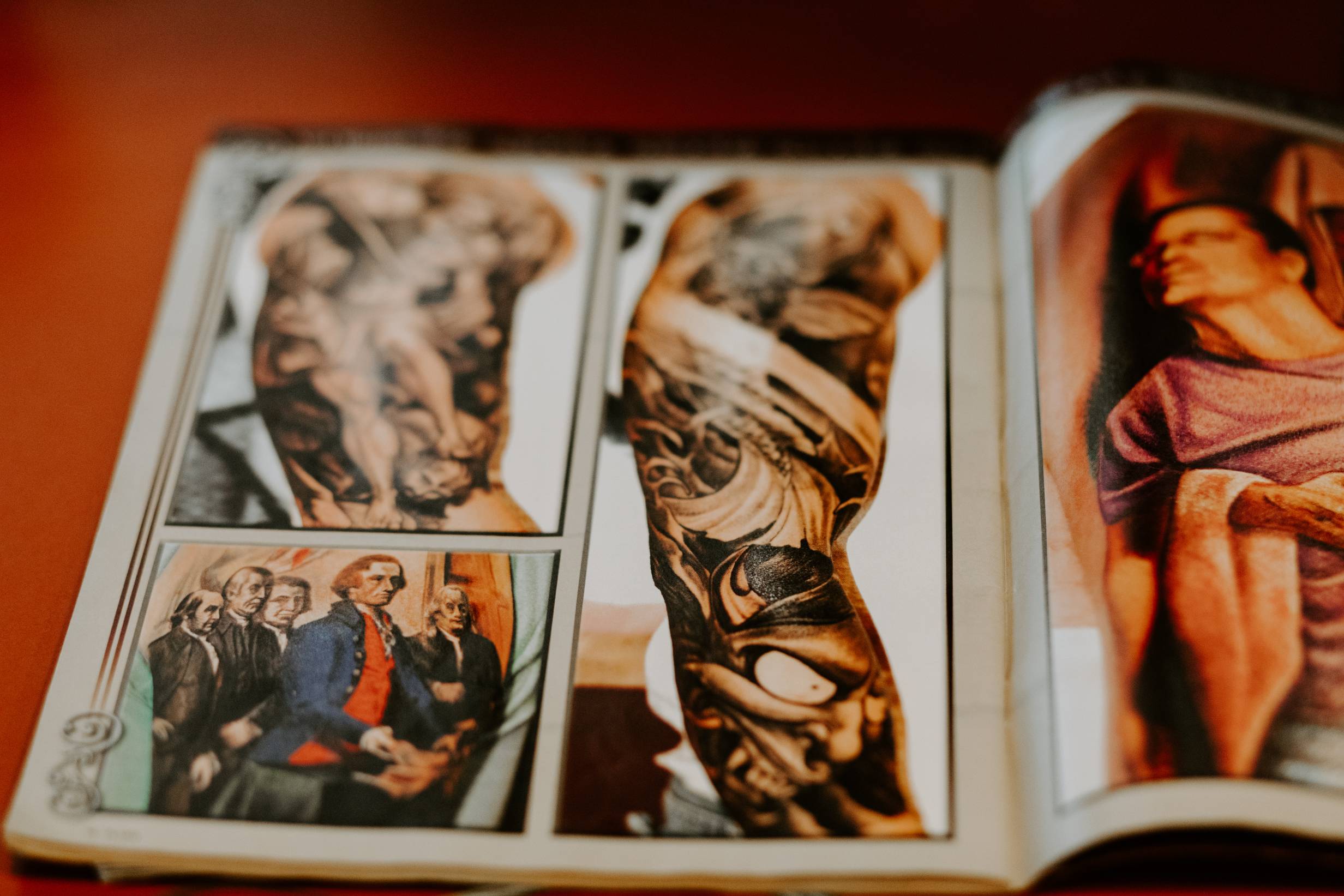I was 23 years old when I got my first tattoo. I always felt getting a tattoo was a big decision that one shouldn’t take lightly. My first was a multi-colored maple leaf on my right arm. Elderly women (my favorite people) loved it. I loved it. I followed it up with sheet music on my chest, and a half sleeve’s worth tribute to IT on my left arm within a year. My tattooed friends warned me that I was going to become addicted to getting tattoos, while my parents insisted that I was wasting my money and tattoos weren’t helping me get a degree. But truth be told, I was out of ideas after that. I wasn’t going to get a tattoo without a reason to get one. What I wished someone had told me sooner, though, was that I was going to be fielding questions on them every time I emerged from my home. “What does that say?” “Did you study music?” “Are you Canadian?”
Don’t get me wrong, I’m not some curmudgeonly old cretin that fears human interaction (maybe somedays), but sometimes it’s a bit tiresome. With all the cultural acceptance of tattoos that has occurred in earnest over the past decade, why is this tactless interrogation still so common? Is it as simple as human awkwardness? Or is it that it is hard to explain the meaning of tattoos to those that don’t have them? Are tattoos just another form of art open to interpretation and appreciation? Or can tattoos only be truly meaningful to the bearer? I’d love to use this opportunity to delve deeper into the ink and the people whom wear it, to explore the importance that this means of expression can have in people’s lives, and to remedy the awkward dialogue that often happens between the inked and the curious. I hope you will join me on this journey.
Born in 1975, Craig Wakefield wasn’t accustomed to seeing many individuals with tattoos. Other than bikers and guys in the military, not many people had them. “They intrigued me at a young age. I was interested in them at twelve or thirteen, maybe. Not sure. I don’t remember anyone from my childhood having a tattoo. Honestly, people ask about my tattoos all the time.” Wakefield admits. “It’s funny because all of my tattoos are something that already exists.”
I always tread lightly when I inquire about another person’s tattoos. I’m not sure it’s always appreciated. In fact, I know it isn’t. But so long as you don’t come off as creepy, it’s usually well received, and at least tolerated. When Wakefield is wearing a t-shirt, there are a few pieces that may spark your interest, even in passing. When I asked him how one should ask about a stranger’s skin art, Wakefield replies, “I’m not going to tell people how to ask about my tattoos.”
Craig Wakefield has over a dozen tattoos. “Fifteen or sixteen. They run together.” Wakefield is a vintage townie in every fashion; born and raised in Homer and working in Champaign-Urbana his whole life. Hearing him talk about campus is a delightful cartography lesson for anyone born after 1988. “That’s one thing that’s really changed. The tattooing process is much the same, but these days there are so many artists. A lot more.” Wakefield’s favorite local artist is well-known, experienced, and has a bit of a reputation for being a complete asshole. But that’s hearsay. And it’s hard to argue with the outcome. “Nick Wiggins. He does good work. Period. He’s done almost all of mine, but I am open to new artists. I want more. How many? All of them.”
Nick Wiggins has been a tattoo artist for thirty years. I asked him how someone should ask about another person’s tattoos and he supported Wakefield’s stance. “I appreciate the curiosity. Why get offended when you can possibly educate? The only irritation I can think of is being touched or positioned uninvited. Don’t grab someone’s arm, for example, just to be able to view the tattoo better.”
It was Wakefield that told me that Wiggins could be an asshole. Personally, I thought it was in an endearing commendation. To me, tattoo artists require a certain rigidity. “Anyone involved for a length of time in this industry will probably have the same said about them,” says Wiggins. “The longer one is at this, the more widespread a reputation becomes. I give what I get.” Asshole or not, I like Wiggins. He keeps to an old school code that I appreciate. “I tell clients that I have a couple of rules. I will not copy another person’s tattoo. Won’t do it. I can, and will, design something along the lines of what they’re showing me. But if the client rejects that, there are plenty of guys tattooing now that don’t have that rule. Also, if a client brings in a drawn request, I inform them that I may need to make improvements to make it a tattoo.” Wiggins explains. “If that doesn’t sit well with the client, I refer to the first rule.”
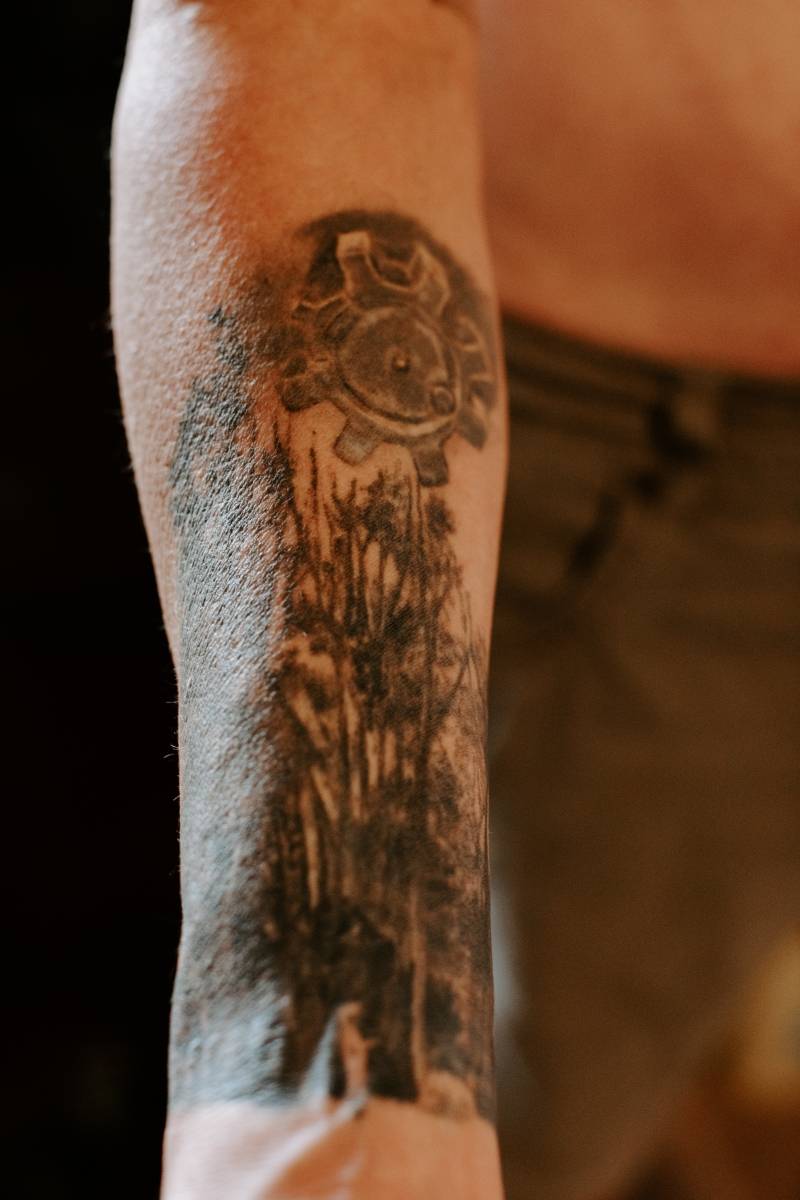
Wakefield left it all to Wiggins and wasn’t disappointed. First, the forearm. Perhaps Wakefield’s most noticeable, typically visible, tattoo is dark and deep. It looks to be a greyscale forest scene and once mentioned, he is eager to discuss it. “This is a photo I took one autumn,” He says, illustrious. “These trees are actually the tree line around my family’s land in Homer. That property, on the outside of town, has been in my family for generations. My daughter happened to be standing in the foreground, and I snapped a picture. The view gave me a good feeling. She was just on her phone, she was around fifteen or so. It was a total accident that worked out well. It’s my favorite piece.”
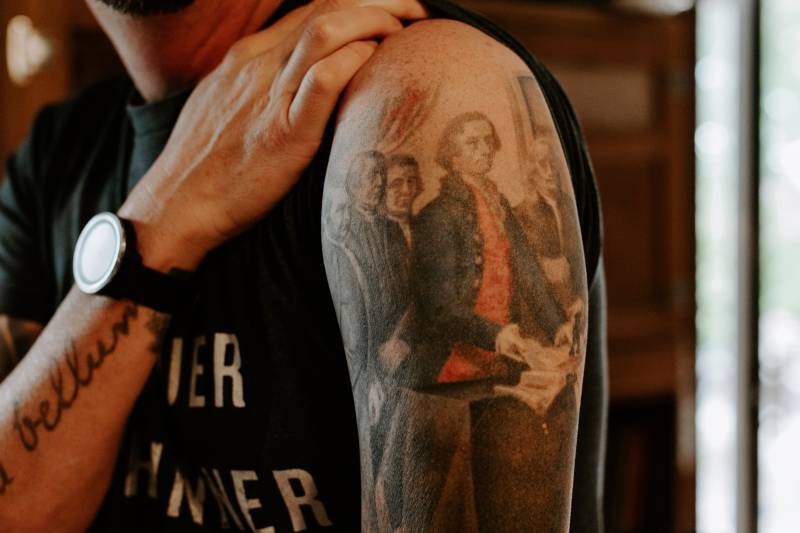
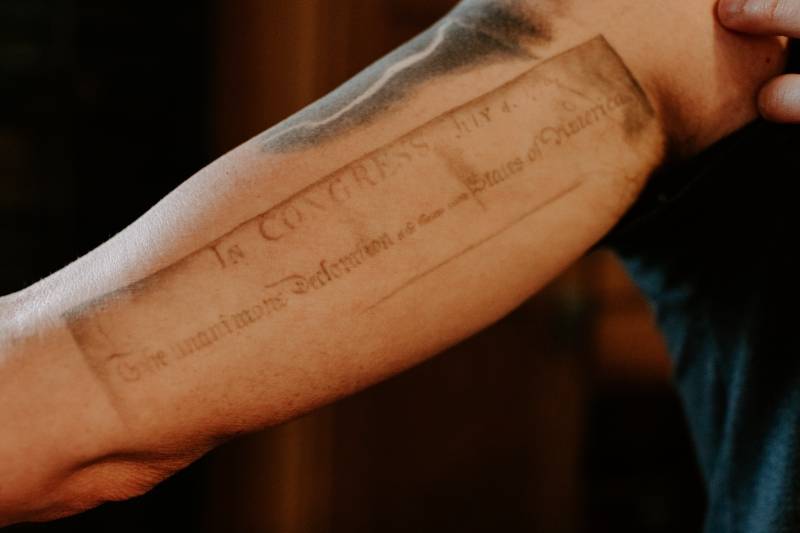
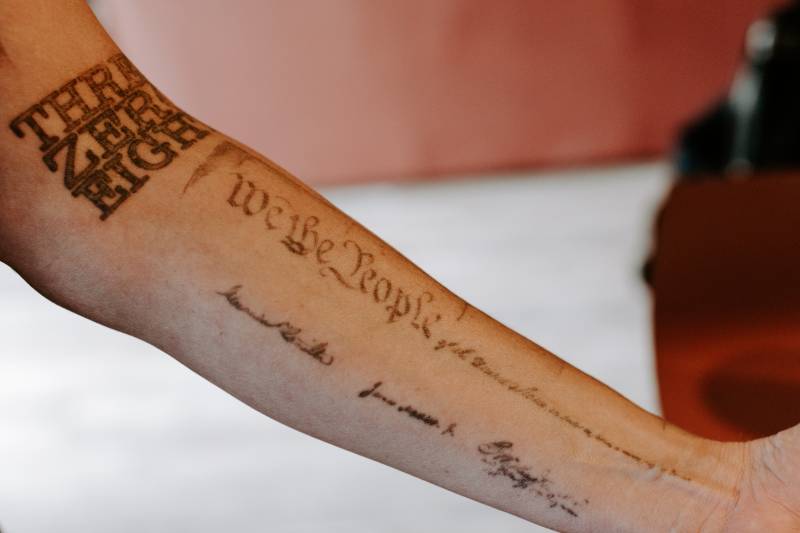
Next, the sleeves. Wakefield has both the Declaration of Independence and the signing of the Declaration of Independence tattooed on his left arm. He could not recall which came first. He’s asked about ‘We The People’, only somewhat visible on the underside of his left forearm. He doesn’t seem to mind the bluntness and answers without a hitch. “That part of U.S. history interests me a lot. The Revolutionary War is the original rebellion in my mind,” he gushes, “There is something I love about the pure defiance and insurgency of the Revolution. Imagine that, a declaration of independence from your government. And the consequences of that.” Wakefield also has some Latin in the hand of John Adams adjacent to this, but we won’t get into all of that.
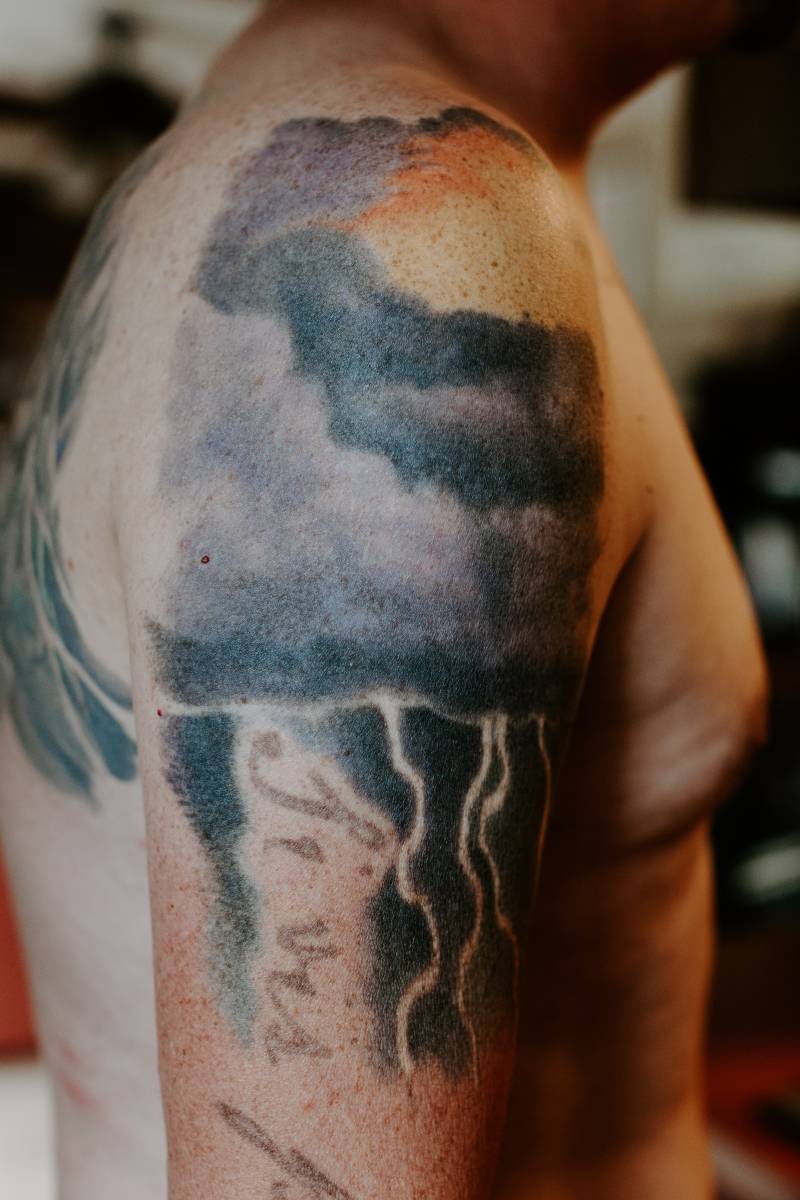
On the right shoulder of Craig Wakefield peeks a cloud. I ask him about this, the lightning, and I am corrected, “It’s a thunderstorm.” Wakefield for the first time shows some hesitance in continuing. “It’s for my mom.” He isn’t initially offering any clues as to the significance of the thunderstorm, only shrugs and admits, “It’s not all I want it to be.” He’s finally prodded and goes to say, “During thunderstorms, it was tradition that my mom, dad, my brother and I would all just bunker down in the living room, in front of the big windows and watch storms roll by and through. I grew up loving thunderstorms. I saw them as entertainment because it was always neat to watch that the way we did.” He takes a deep breath. “It wasn’t until decades later that I learned my mom, whom began this tradition, was absolutely terrified of thunder and lightning.” I smile, maybe inappropriately, and Wakefield gets it. “All those years she would sit there petrified just so we wouldn’t grow up to be afraid of thunderstorms, like she was.” Wakefield is succumbing to a bit of a grin now. “I got this two weeks before she died.”
It’s not always easy talking to strangers about our tattoos. It can be tough explaining some of the heavy things they can represent. But I think if we make the effort to speak up, others may find it easier to ask about them politely and hear us out when we have a story to tell.
Photos by Kelsey Greene








